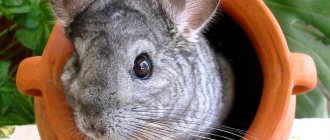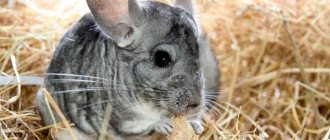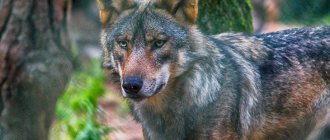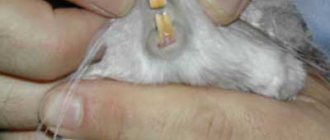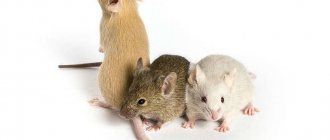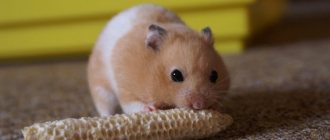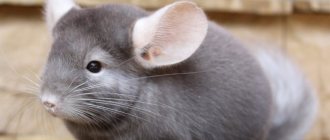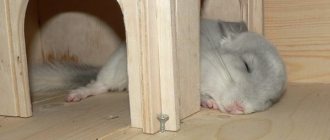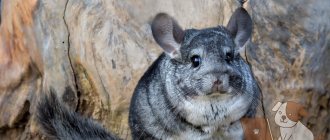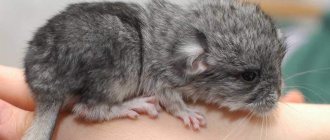Well, is it possible to remain indifferent to such an animal as a chinchilla? These miniature rodents with bright, beady eyes, a silky shiny coat and a fluffy tail, at first sight evoke sympathy and a desire to pick up the charming creature.
Unfortunately, not everyone loves the chinchilla. Lovers of natural fur consider these creatures only as a fashionable fur coat, and there are many mercantile people who rush to satisfy the whims of rich ladies. Spontaneous hunting for chinchillas has already led to the fact that there are almost no chinchillas left in the natural environment, and according to the latest data, there are hardly 10 thousand individuals in the wild.
These beautiful creatures are listed in the Red Book as an endangered species, but it is unlikely that animal activists will be able to save chinchillas from complete extinction, and perhaps the next generation will only see the furry rodents in pet stores or, in general, in pictures of wildlife magazines.
A brief excursion into the history of the origin of chinchillas
These beautiful rodents resemble hares, squirrels, and rats at the same time. Surprisingly, chinchillas have nothing in common with the above animals except external resemblance, and their closest relative is... the porcupine. There is also a version that chinchillas have a common ancestor with viscachas - long-tailed rodents that also live in the Andean mountains.
Chinchilla in its natural environment
Scientists believe that the genus of these rodents has ancient origins, and their age is more than 40 thousand years. They base their judgments on the fact that the remains of an unknown prehistoric animal were found in the Cordillera, the bones of which are very similar to the anatomical structure of the body of modern chinchillas.
The Inca tribes, whose empire stretched from Chile to Ecuador, have mined chinchilla skins for clothing and household items since time immemorial. Interestingly, they were not the first to pay attention to the valuable fur of these rodents. Before the arrival of the warlike Incas, the territories at the foot of the Andes belonged to the Chincha people, and it was from them that the conquerors adopted the tradition of hunting furry animals. By the way, it is believed that the name “chinchilla” itself comes from the name of the Chincha tribe, who sold their skins to all nearby settlements.
But the Indians were careful about nature, so chinchilla fishing was under the strict control of local priests, so the population of these animals was not threatened. The conquest of South America by Europeans was a real tragedy for furry creatures. Beginning in the 15th century, Spanish and Portuguese colonists exported from the New World not only gold and precious stones, but also beautiful chinchilla fur.
Unlike the Indian tribes, the Europeans, greedy for money, did not care at all about the safety of these animals, and killed them in the millions. The greed and gluttony of the invaders has led to the fact that within 4 centuries the number of chinchillas in the wild has fallen to catastrophic levels, and in some regions the animals have completely disappeared.
In the middle of the 19th century, the authorities of South American countries finally came to their senses and imposed a ban on chinchilla fishing. But by that time, rodents were already on the verge of extinction, and severe punishment for poaching could not stop lovers of easy money, so it was not possible to restore the chinchilla population in their natural habitat, and it is likely that in the near future these amazing creatures will be raised only in captivity.
Description of the rodent
— Advertising —
The chinchilla has a round head on a short neck. Body length is from 22 to 38 cm, tail length is 10-17 cm, it is covered with hard guard hairs. The eyes are large, the ears are round, 5-6 cm long, the whiskers are 8-10 cm long. The hind legs are four-toed, twice as long as the front five-toed ones, which allows the rodent to make high jumps. The auricles have special membranes that cover the ears during sand baths.
The thick and warm fur of chinchillas is necessary for the animals to survive in the cold mountain climate. This is one of the densest types of fur in animals: there are more than 25,000 hairs per 1 cm2 of skin. 60-80 of them grow from each hair follicle. Chinchillas do not have coarse guard hairs. Parasites cannot even live in such dense fur. Chinchillas do not have sweat or sebaceous glands; their fur gets wet in water and the chinchilla is not even able to stay on the surface. To get rid of moisture, remove lost hair and clean the fur of chinchillas, they take baths made from volcanic ash and fine dust and sand.
Where do chinchillas live in the wild?
The original homeland of these furry animals is South America, and their territory of residence is limited to three countries: Bolivia, Argentina and Peru. To be even more precise, chinchillas are distributed only in the highlands of the South American Andes, inhabiting inaccessible areas of rocks that are located at an altitude of 1000-4000 meters above sea level.
Chinchilla in his cave among the rocks
It would seem that in such an arid and harsh area as the northern Andes, it would be difficult for any animal to survive, but chinchillas have perfectly adapted to the local climate. These animals are not afraid of cold winds or frosts, and thanks to their thick, dense fur coat, they can easily withstand temperatures down to -30 degrees. And rocks and crevices serve as a reliable refuge for chinchillas from predators and a place where they can safely raise their offspring.
Mountain viscachas
The mountain viscacha genus is represented by three species:
- Southern,
- Patagonian,
- Northern.
Initially, the animals inhabited the mountainous regions of Peru, from where they eventually spread to the territory of Chile and other South American countries. Externally, mountain viscachas look more like large squirrels than chinchillas. They differ from other relatives in that they are often active during the daytime. They prefer to live at an altitude of four to five thousand meters, although individual populations are also found in lower mountainous areas. They prefer to settle on open rocks and choose places with dry and sparse vegetation. Most of the diet consists of lichens, mosses, succulents and roots.
Lifestyle of chinchillas in their natural environment
These are nocturnal animals; during the day they hide in holes and among stones, and become active only at dusk. Small rodents live in colonies numbering up to two to three dozen animals. True, in former times, when chinchillas had not yet become the object of mass hunting, the number of their groups could reach up to 100 individuals.
Chinchillas have an extremely flexible and plastic skeleton, so they can fit into even the narrowest crevices. And thanks to their large black eyes and sensitive whiskers, these animals are excellent at navigating in the dark.
What sounds do chinchillas make?
In nature, chinchillas live in groups and have developed a way of communicating with sounds. Their range ranges from a soft and quiet purr to a sharp whistle:
- mating rumbling calls of the male to mate;
- squeaking of babies - a demand for mother's attention or food;
- protest - sharp sounds that chinchillas make when quarreling or warning of danger;
- Chinchillas make very sharp and high-pitched sounds when angry, in a state of severe fright or when feeling pain.
What do chinchillas eat?
In the wild, the diet of furry animals is quite meager and monotonous. They mainly eat plant foods: grasses, bush twigs, seeds and lichens. Chinchillas do not disdain the roots and fruits of plants; they willingly eat the bark of young trees. There is little precipitation in the highlands of the Andes, there are almost no natural bodies of water, so rodents replenish their water balance with succulent shoots of cacti. Chinchillas also love to eat insects, various beetles and their larvae.
chinchilla eats a piece of apple
Natural enemies
Large predators are not found in chinchillas' habitats, but they still have plenty of enemies. First of all, these are foxes that set up ambushes near the burrows of furry rodents, and patiently wait for the prey to carelessly emerge from its hiding place. Snakes often sneak into the gorges favored by chinchillas, and owls and eagle owls lie in wait for them in the pre-dawn hours. Taira is also not averse to hunting them - a predator from the mustelid family, whose small size allows it to deftly penetrate into the chinchillas’ lair, grabbing the first animal it comes across.
Camouflage color helps chinchillas successfully hide from predators
But the most dangerous enemy for these amazing creatures was and remains man, who, because of their beautiful fur, almost completely exterminated chinchillas in their natural habitat.
Types of chinchillas and their features
Many people think that chinchillas in nature are the way we are used to seeing them at home in cages. In fact, these rodents come in two types: short-tailed (or coastal) and large long-tailed (mountain), which is exactly what is shown in the photo. The latter live at an altitude of over 2000 meters and are distinguished by increased density of fur. A distinctive feature of mountain individuals is the hump on the nose. It is formed by the convexity of the front part of the nasal bones. Due to the expansion of the cavity, the cold mountain air inhaled by the animal is better heated. The chinchilla's habitat also determines the good development of the cerebellum. They move easily through the mountains and can quickly respond to danger. This more than compensates for the weakness of monocular vision.
Coastal rodents have a different body structure from mountain ones; they:
- less;
- with longer ears and tail;
- narrow at the shoulders.
Currently, chinchillas live in hard-to-reach places, most often rocky slopes.
Social structure and reproduction of chinchillas
As already mentioned, furry animals lead a collective lifestyle, and matriarchy reigns in their community. Female chinchillas are larger than males, and it is they who make all the important decisions: where the flock will settle, when to leave the shelter, and how far to go in search of food. Interesting fact: the female also selects several sentries every night, who, while the rest of the family is feeding, must monitor the environment and, in case of danger, sound an alarm.
Chinchilla family
In difficult times for the colony, when there is not enough food, females have the right to expel a couple of males from the colony or even kill them in order to give the entire colony a chance to survive.
Chinchillas are monogamous and form strong mating alliances for their entire life period. Females become sexually mature at the age of 6 months, and males are ready to mate at the ninth month of life. The duration of pregnancy is from 3 to 3.5 months, and females can bear offspring no more than three times a year.
In one litter there are from one to three babies, which are born covered with fur and with open eyes. Already in the second week of life, furry cubs begin to try plant foods, but for another two months they feed on mother’s milk.
Baby chinchillas
Elena
Ask a Question
Question to the expert
Please tell me how many years do chinchillas live?
In the wild, these animals live 18-20 years. And in captivity, their life expectancy ranges from 13 to 15 years.
Diet of the animal
Feeding chinchillas consists of giving concentrated, juicy and roughage, as well as animal feed and vitamins.
Roughage
Rough food includes hay, tree bark, twigs and dried brooms. The best hay option for an animal is legume-grain hay with a large proportion of alfalfa, vetch or clover. However, it is not advisable to feed exclusively bean hay (although this is what the animal eats with great pleasure) - it causes fermentation in the intestines and diarrhea.
Nettle brooms are also useful for animals. And to grind down teeth you need branches of bushes or trees.
Concentrated feed
Concentrates include legumes, various grains, seeds and cereals, bran and even bread. Ready-made feed mixtures for chinchillas also belong to concentrated feeds. A ready-made feed mixture is an excellent option for feeding one or two chinchillas, however, with a large number of animals, it is much more practical and economical to create a grain mixture from various crops.
Of all the grains, the chinchilla eats with particular pleasure:
- Oats,
- Barley,
- Millet,
- Corn,
- Wheat.
- Barley.
It is not recommended to feed to young animals: the grain has a lot of useful components, but is very hard. Adults are recommended to feed crushed barley.
Oats
The most valuable product in the chinchilla diet. It contains a lot of protein and essential fats. You can give the animals both oatmeal and rolled oats. Oatmeal soaked in milk is especially recommended for nursing females. When making a grain mixture, the proportion of oats can reach up to 70% without harm to the animal.
Millet
When choosing millet, it is better to give preference to varieties rich in carotene. It is especially good to simply add to the mixture for feeding young animals and show animals.
Corn
Corn grains are very rich in protein, but this type of protein is less easily absorbed by the chinchilla’s body. Therefore, it is not recommended to feed too many grains. Animals happily eat milk corn, which has a pleasant sweet taste. Dairy corn can even be fed on the cob. The proportion of ripened grain in the feed mixture can reach up to 50%, and for digestibility it is recommended to grind it well.
Wheat
Contains quite a lot of proteins and carbohydrates. It is recommended to grind wheat grains before feeding. Excessive use of wheat in the grain mixture can lead to obesity in the animal.
Grain or grain mixture is fed only in dry form.
It is recommended to change the composition from time to time, diluting the food with dried fruits, legumes or seeds. The animal eats this type of food with great pleasure.
Crumbly porridges cooked without adding oil, salt and other seasonings and in water are also good food. Porridge made from rice, millet, oatmeal, peas and even corn is suitable for feeding.
Another important type of feed is sprouted grain. It is simply necessary for breeding animals during preparation for the breeding season, during mating, during pregnancy and lactation. This grain is very rich in vitamins E and B, which play an important role in the activity of sperm, the formation and development of embryos.
Seeds
The seeds are useful because they contain a lot of fatty acids. Chinchillas love them. Seeds are especially important in the diet of young animals and show chinchillas, since the appearance, shine and thickness of the fur depend on them. The share of seeds in the feed mixture can reach up to 22%.
Legumes
Soybeans, regular beans, lentils and peas are very rich in protein. Legumes can be part of the feed mixture or used as a separate feed. However, it is impossible to feed exclusively legumes - they provoke digestive upset. The share of legumes in the feed should not exceed 10%, and it is better to add them in ground form.
Nuts
All types of nuts are nutritious and highly digestible food. Hazel is most useful for animals - it contains:
- About 70% fat,
- About 20% protein
- About 8% sugar.
However, overfeeding with nuts leads to sad consequences, including poisoning, diarrhea, obesity, and allergies. It is best to give nuts as a treat no more than twice a week.
List of products that can also be used:
- Rice cereal,
- Buckwheat,
- Barley grits,
- Cornflakes,
- Herb seeds,
- White bread crackers,
- Pumpkin and watermelon seeds, zucchini.
Types of chinchillas
At the moment, only two species are included in the genus of these animals: the large short-tailed chinchilla and the small long-tailed chinchilla.
Large long-tailed chinchilla
Large, short-tailed chinchillas were once widespread throughout Peru, which is why they were also called Peruvian. These are large rodents with a short tail covered with stiff hairs and a light gray coat. Their luxurious light fur was a desirable prey for poachers, which led to the almost complete extermination of the animals. Now large chinchillas can still be found in the mountains of Argentina and Bolivia, but their population is on the verge of extinction, and is included in the registers of the International Union for Conservation of Nature.
Small short-tailed chinchilla
The small (or common) long-tailed chinchilla is a resident of the Chilean Andes, preferring to settle in the lowlands of high-mountain plateaus, which is why they got the name coastal. They differ from their short-tailed fellow creatures by their more modest dimensions, long, densely pubescent tail and dark color. In the wild, their numbers have also reached a critical point, but the subspecies of small chinchillas is bred on farms as a source of industrial fur, and in nurseries as pets.
Until the 19th century, there was another variety of these animals - the royal chinchilla. They were the largest representatives of the chinchilla genus, reaching the size of a hare, and possessing long, bluish-gray fur. The reason for their disappearance was uncontrolled hunting, and now the only specimen in the form of a stuffed animal is kept in the German Museum of Natural History.
Final table of chinchilla species according to user ratings
Long-tailed
0
Short-tailed
0
Interesting facts about the rodent:
- The word "chinchilla" comes from the name of the Peruvian province of Chincha, which is located in Peru.
- The vocal behavior of chinchillas is very interesting. If they don't like something, they make a sound that resembles a quack or chirp. Very angry chinchillas begin to growl and, as it were, “blow their nose,” quickly clicking their teeth. If the animal gets hurt or gets very scared, it begins to squeak loudly. When threatened, chinchillas attack, stand on their hind legs, growl and let out a stream of urine, and then can grab the offender with their teeth.
- The use of chinchillas as a source of valuable fur in Europe and North America began in the 19th century, but a high demand for their skins still exists today. You need to spend about 100 skins on one fur coat, which is why chinchilla fur coats are the rarest and most expensive. For example, in 1928, the cost of a chinchilla coat was half a million gold marks. And in 1992, a chinchilla fur coat cost $22,000.
- The long-tailed chinchilla is kept as a pet and is also bred for fur on special farms and in private households. The fur of the long-tailed chinchilla is grayish-bluish in color, very soft, thick, and durable. The short-tailed chinchilla's fur is of slightly lower quality.
How chinchillas were domesticated
When the demand for the luxurious fur of these animals throughout the feast reached unprecedented proportions, many people began to think about raising chinchillas in captivity. But all attempts to domesticate furry creatures failed, because no one knew what conditions they needed for reproduction, or even how to properly maintain them. And only the American Matthias Chapman managed to successfully breed these animals and establish the first chinchilla farm.
Breeding chinchillas on a farm
It is noteworthy that initially Mr. Chapman did not have such a goal. He had never worked with animals, since he was a mining engineer, not a breeder, and did not even know about the existence of chinchillas. Matias was working in a mine in Chile, and one day a local Indian approached him with a strange animal in his arms. The interested engineer began asking the visitor about his pet, and he offered to buy the rodent. The American didn’t even hesitate, he really liked the fluffy animal, and without hesitation paid the Indian the required amount.
Treats
Treats for chinchillas are used not only as something rewarding, but also as an additional source of minerals and vitamins. Most often, treats are given separately from the main food.
As a treat you can give:
- Hawthorn fruits,
- Dog-rose fruit,
- Rowan berries,
- Black currant berries,
- cranberries,
- Apples,
- carrots,
- Hibiscus inflorescence,
- Common calendula flowers,
- Linden flowers,
- Bell pepper,
- parsley roots,
- Dandelion roots.
However, many novice breeders try to feed their pets with these harmful products and end up with poisoning, severe diarrhea and even death.
Keeping a chinchilla at home
The popularity of these creatures is associated not only with their beautiful appearance, but also with their unpretentiousness in home maintenance. Chinchillas do not need street walks, do not require constant attention from the owner, and, being very clean, they themselves take care of their luxurious fur coat.
Cell selection
Don't think that a chinchilla can live in an old aquarium or even in a shoebox! Any pet requires optimal living conditions, and furry rodents are no exception in this regard. Therefore, the first thing you should take care of before buying an animal is a spacious and comfortable home for the animal. The cage must be equipped with a feeder, drinking bowl, house and shelves.
There are two types of chinchilla cages:
- Metal. They are very popular among rodent owners, as they are relatively inexpensive and easy to clean. Among the disadvantages, it can be noted that leftover food, hay and filler granules will be scattered both near the cage and on the floor.
- Display cases. This is a more expensive option, which is a structure made of a wooden base, with walls made of fine mesh and glass. The advantage of such cages is good sound insulation, and the pet’s night fussing does not cause much inconvenience to the owners. The downside is that they are difficult to clean, and the wooden tray swells with moisture over time and absorbs unpleasant odors, so the display cases require periodic replacement.
If the chinchilla’s cage is small, then do not clutter it with unnecessary accessories: ladders, hammocks, tunnels. The rodent must move freely, having space for maneuvers and jumps.
Care
Caring for a small pet will not cause you much trouble; in fact, you will only have to spend a little time cleaning the cage. Change the hygienic filler every 2-3 days, wash the tray about once a week, and keep the feeder and drinker clean. Also regularly clean the accessories from your chinchilla’s home from dust and hair.
chinchilla takes a sand bath
Question to the expert
Is it possible to bathe a chinchilla in water?
Absolutely not! In the wild, these rodents clean their fur by bathing in volcanic ash, and when kept in captivity, they need special sand for bathing, which can be purchased at any pet store.
What and how to feed
Feeding chinchillas in captivity should be as close as possible to their diet in the natural environment. These are herbivorous animals, so the basis of their menu is cereals and hay. Industrial food for chinchillas is presented in the form of grain or granular mixtures, which, in addition to cereals, contain useful herbal supplements and minerals. The rodent is fed once a day, usually in the evening, pouring 2-3 tablespoons of food into a bowl.
Chinchilla eats a treat
Chinchillas also need to be given hay daily, which improves the animal’s digestion, and fed with fresh herbs and tree branches. As for treats, pets are sometimes pampered with dried fruits (raisins, dried apricots, dates) and almonds, peanuts or raw pumpkin seeds.
In nature, chinchillas do not drink water, receiving the necessary moisture from cacti and mosses. But at home, your pet’s cage should always have a drinking bowl with clean, fresh water.
One of the characteristics of chinchillas is that their teeth grow throughout their lives, and animals need to constantly grind them down. In nature, animals solve this problem with the help of tree bark or cobblestones, but in captivity they need a special sharpening stone-mineral.
Animal feed
From bran
From grain crops
When thinking about what to feed your chinchilla, you must not lose sight of succulent food. They form the basis of the animal’s diet. Juicy food is: various greens and fresh grass, fruits, root vegetables and vegetables.
List of foods allowed for feeding:
- Tomatoes,
- cucumbers,
- Zucchini,
- Pumpkin fruits,
- carrots,
- Sweet potato.
The fruits the animal eats most readily are:
- Figs,
- Sweet pear varieties,
- Apple,
- Banana,
- Red grapes (green - only sweet varieties),
- Various berries.
The most recommended greens are:
- Clover,
- Dandelion leaves and stems,
- Alfalfa,
- Stems and leaves of common nettle,
- Vegetable tops,
- Tree branches.
It is recommended to feed succulent food in the morning and afternoon, and grain food in the evening. The combination of these two types of food can cause digestive upset.
Feeds of animal origin include powdered and regular milk, whey, yogurt, cottage cheese, meat and bone meal. This type of food is required for pregnant and lactating females, as well as for young animals. The content of such feed in the daily diet should not exceed 5%.
Vitamin supplements
Vitamins for chinchillas cause a lot of controversy among large breeders. There is no single opinion as to whether they should be added to the diet, in what quantity and which ones exactly.
If the animal’s diet is varied enough, then you can do without a vitamin supplement. But in conditions of a large population on a breeding farm or in a nursery, it is not always possible to create a complete diet taking into account the taste preferences of each animal. Therefore, most breeders prefer to include various additional additives in the animal’s diet. This is especially important during the breeding season, feeding and during the growth of young animals.
Vitamin Vita Sol is good for pregnant and lactating females. This type of vitamin is water soluble. Add ten drops of vitamin to a 250 ml container of water. Another type of water-soluble vitamin is Vitamin Sulfur Plus. It is given according to the instructions.
Ten drops of the vitamin are diluted in 250 ml of water. It is not recommended to give these vitamins constantly, as this will lead to an excess of vitamin D. It is most preferable to give a course of the vitamin to animals before exhibitions, to older young animals before sale, and to breeding animals in preparation for the breeding season.
Character and habits of chinchillas
Recommended by topic
Cow Horse Rabbit
In general, these animals can be characterized as friendly, peaceful and affectionate creatures. They are not aggressive, they do not have the habit of biting, even if a chinchilla is afraid of something, it will not actively defend itself, but will try to hide in a secluded place.
But each animal is individual, and furry pets are no exception in this regard. Among chinchillas, according to their temperament type, there are both phlegmatic and choleric, which means that their behavior has its own characteristics. Rodents with a phlegmatic character are more restrained and balanced, they sleep almost all day in their house, and they are not too active at night, preferring to slowly and calmly study their surroundings. Choleric chinchillas are distinguished by their inquisitive and active nature, they are interested in every subject, and they attentively react to any extraneous noise.
Chinchilla plays with a keychain
Whatever type of character a chinchilla has, remember that these are very timid animals. Therefore, do not play loud music in the room with your pet’s cage, and do not arrange loud family disputes or noisy parties near him.
Games and physical activity
These are very playful and active animals that simply love to walk around the apartment. A chinchilla will never miss an opportunity to sneak out of its cage and go explore the world. And considering that this is a rodent, after such entertainment for your pet you will find chewed shoes, sofa upholstery and wires. Also, an animal, frightened by a loud sound, can hide under a closet, from where it will be very difficult to get it out.
So experts do not recommend letting your chinchilla out of its cage, but rather purchasing a running wheel to satisfy its active needs. As a last resort, you can fence off an area on the floor in which your pet can frolic without causing damage to the apartment.
Chinchilla in a running wheel
Maintenance and care
The first thing a pet chinchilla needs is a large and spacious cage. It is best if it is high.
We invite you to familiarize yourself with Golden Chinchilla (goldbar color)
Keeping and caring for a chinchilla is simple. For a pet to live comfortably, it is necessary to maintain a certain temperature in the room.
Chinchillas cannot tolerate high temperatures, so it is best to place their cage in a cool place. The best option is 20-22 degrees Celsius.
You can also purchase a special display case for your pet chinchilla (look at the photo to see what it looks like). Your pet will love it if it has enough space to move around and play.
The bottom of the cage must be covered with sawdust or special filler. It is quite difficult to train a chinchilla to go to the toilet in one specific place. This bedding is changed at least once a week. It is better to hang the feeder.
This is the basic care for a chinchilla, which will not require much labor. The most important thing is to treat your pet with care, follow the diet and hygiene procedures, and give him the necessary attention.
